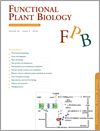
Functional Plant Biology
Volume 45 Number 5 2018
FP17265Biochemical and transcriptomic analysis of maize diversity to elucidate drivers of leaf carbon isotope composition
Leaf carbon isotope composition (δ13C) has been used to screen for water-use efficiency in C3 plants, but gaps in the understanding of factors influencing δ13C have limited its application in C4 species. This study exploited maize genetic diversity to explore biochemical and post-photosynthetic factors that may influence δ13C. Our findings indicate that the observed variation in leaf carbon isotope composition across diverse maize lines is likely driven by differences in stomatal and mesophyll conductance and not photosynthetic or respiratory metabolism.
FP17233Impact of hemlock woolly adelgid (Adelges tsugae) infestation on xylem structure and function and leaf physiology in eastern hemlock (Tsuga canadensis)
Hemlock woolly adelgid (HWA) is an invasive insect that feeds upon the foliage of eastern hemlock trees leading to a decline in health and mortality. During early infestation, HWA-induced decline in the health of eastern hemlock is not initially caused by compromised water transport or needle loss. Our results contribute to efforts to understand the mechanisms leading to the demise of eastern hemlocks.
FP17180The regulator of G-protein signalling protein mediates D-glucose-induced stomatal closure via triggering hydrogen peroxide and nitric oxide production in Arabidopsis
Stomatal guard cells sense and respond to sugar, but the means by which they do so have not been fully elucidated. Our study showed that RGS1, a putative receptor for D-glucose, mediates D-glucose-induced H2O2 and NO production in guard cells and subsequent stomatal closure. The data suggest that photosynthetic product D-glucose, as an integrative signal, coordinates plant CO2 uptake with water loss.
FP17199Seasonal variations of leaf chlorophyll–protein complexes in the wintergreen herbaceous plant Ajuga reptans L.
In the perennial herbaceous wintergreen plant Ajuga reptans (bugle), the photosynthetic apparatus (PSA) is reorganised during winter. The aim of this work was to examine the structural changes in the pigment–protein complexes of PSA. Changes in aggregation of the thylakoid protein complexes were observed including a restructuring of the PSI–PSII megacomplex and the PSII–LHCII supercomplex parallel to changes in the zeaxanthin-dependent protective mechanism.
FP17288Identification of MdDof genes in apple and analysis of their response to biotic or abiotic stress
In the study presented we identified MdDof genes in apple and analysed their response to biotic/abiotic stress. The aim of the work was to give references to understand the function of MdDof genes generally and serve as a reference for studies of Dof zinc finger genes in other plants. Finally, we fit the original images into the software Photoshop 6.0 for bigger pictures.
FP17212Structural and functional characterisation of two novel durum wheat annexin genes in response to abiotic stress
Abiotic stress reduces the grain yield of cereal crops. Here, we show that the two durum wheat annexin genes, TdAnn6 and TdAnn12, are induced by different abiotic stresses and heterologous expression in yeast improves tolerance to different stresses. These results show that the two annexins are potentially useful candidate genes for engineering abiotic stress tolerance in cultivated plants.
FP17274Hydrogen sulfide may function downstream of hydrogen peroxide in mediating darkness-induced stomatal closure in Vicia faba
We proved for the first time the effects of H2S, a novel gasotransmitter, on darkness-induced stomatal closure and the relationship with H2O2 in Vicia faba. Here we found that H2S mediated darkness-induced stomatal closure in Vicia faba and it acted downstream of H2O2 in this process. This work enriches the signalling network during darkness-regulated stomatal movement and provides evidence for further research.
FP17147XopR TTSS-effector regulates in planta growth, virulence of Indian strain of Xanthomonas oryzae pv. oryzae via suppressing reactive oxygen species production and cell wall-associated rice immune responses during blight induction
Bacterial pathogens secrete effectors to modulate plant immunity, enabling unlimited pathogen growth inside host, and causing disease. Xanthomonas oryzae pv. oryzae executes XopR effector to suppress immune responses in rice for its growth and subsequent blight disease. This finding provides insights into understanding the key weapon used by the pathogen, and will help to identify the novel targets for disease management.
FP17226Constitutive expression of CaHSP22.5 enhances chilling tolerance in transgenic tobacco by promoting the activity of antioxidative enzymes
Chilling stress limits the productivity and geographical distribution of many plants throughout the world. Accumulation of the endoplasmic reticulum-located small heat shock protein CaHSP22.5 enhanced photochemical activity and oxidation resistance and alleviated endoplasmic reticulum stress caused by chilling stress in transgenic tobacco plants. CaHSP22.5 could be useful for improving the tolerance of chilling-sensitive plant types.



